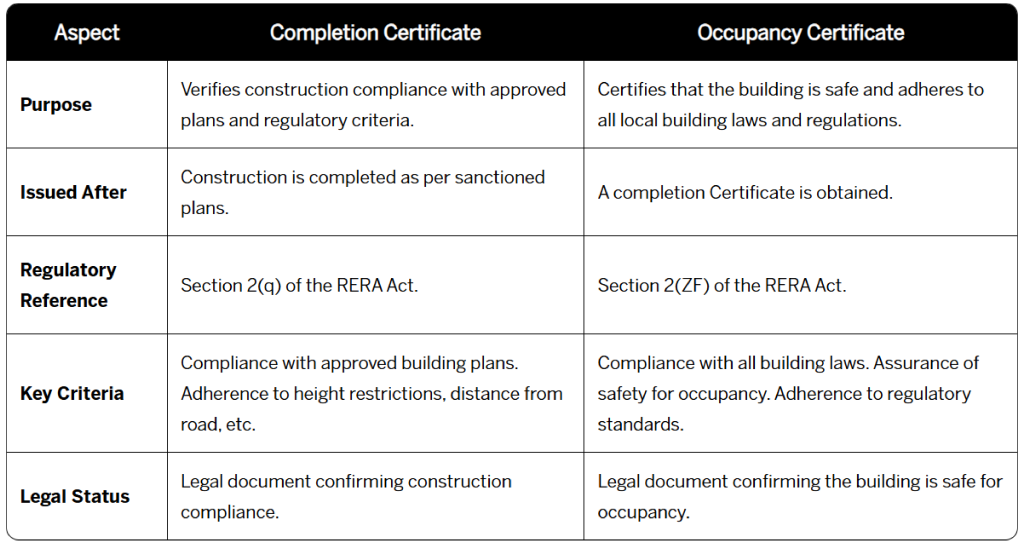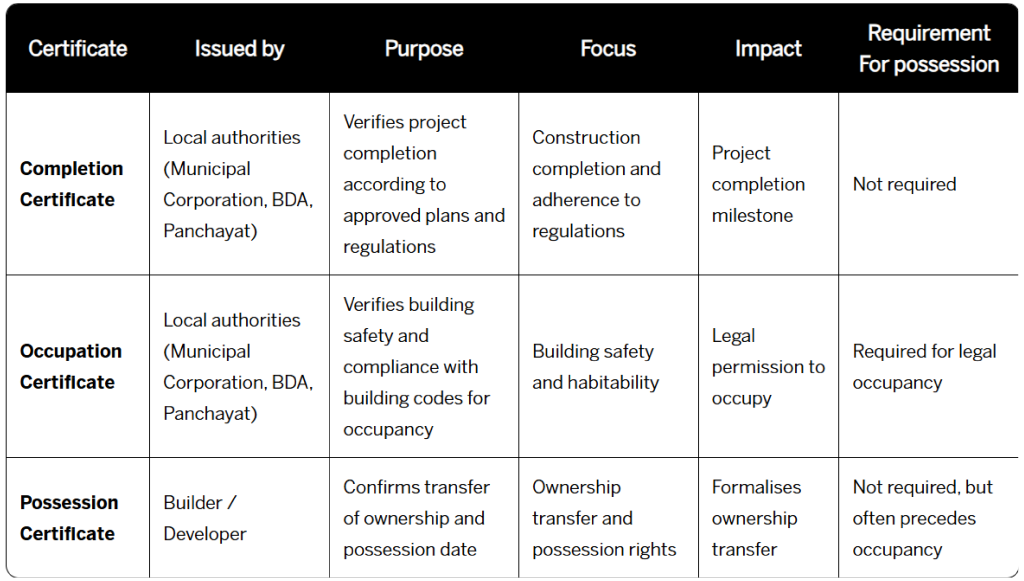Table of Contents
- Introduction
- What is a certificate of occupancy?
- What is the Importance of OC (Occupancy Certificate)?
- What is a Partial Occupancy Certificate?
- How do you get a certificate of Occupancy (OC)?
- How to check OC ( Occupancy Certificate) status online?
- How do you check occupancy certificates online in Bangalore?
- How to check an Occupancy Certificate (OC) Offline?
- What are the parameters checked before issuing an Occupancy Certificate?
- Key takeaway:
- OC can impact resale value and loan approval
- Legal implications of missing OCs
- Do I need an Occupancy Certificate (OC) to get insurance for my property?
- Completion Certificate
- Who Can Apply?
- What is the difference between CC and OC?
- Completion Certificate Vs Occupancy Certificate Vs Possession Certificate
- Can I Buy a Property Without an OC?
- What does an OC mean for the Homeowner?
- What if my property is under BDA or Panchayat?
- What legal action can be taken if the builder fails to provide an OC?
- How long does it take to obtain OC?
- Conclusion
Introduction
Finally, you have found your dream home after months of tireless searching! Now, mountains of paperwork threaten to turn your excitement into a headache. Do not let terms like OC and CC puzzle you. Having an idea about them can help you as a homebuyer to be more confident and make sensible decisions. So let us understand what OC & CC means so that you are ready to ask the right questions and be sure of investing in a safe and legal property.
What is a certificate of occupancy?
An Occupancy Certificate (OC) is an official approval granted by the local government body (BBMP, Panchayat) confirming that the building has been constructed according to approved plans and complies with all building codes, making it safe for occupancy.
This certificate ensures transparency in the construction process and confirms compliance with statutory requirements. It also verifies that the building has access to essential facilities such as water, electricity, proper ventilation, fire safety measures, and sanitation.
What is the Importance of OC (Occupancy Certificate)?
-
Legal :
An OC strengthens the claim of ownership and can help in resolving any future disputes regarding rightful ownership.
-
Increased Value :
Properties with a valid OC are generally considered safer and more desirable by potential buyers.
-
Safety and Security :
An OC signifies that the building has been constructed following safety regulations, minimising potential risks for residents.
-
Insurance Coverage :
Insurance companies consider an OC a key factor when evaluating risk. Without an OC, securing property insurance can be difficult or expensive due to perceived higher risk.
-
Trust in Builder :
Without OC, developers/ builders cannot guarantee that they have obtained all required authorisations and permissions from the concerned authorities.
What is a Partial Occupancy Certificate?
A Partial Occupancy Certificate (POC) or Temporary Occupancycertificate is generally issued to projects that are large-scale or have different phases in them. In that case, a Partial Occupancy certificate will be issued before the entire project is finished and it may not include all the planned amenities. However, this is only temporary, with a validity period extending until the project’s completion.
Builders have seven years from the POC issuance date to finalise the project. Once complete, the developer has a 30-day window to apply for the OC, the official document signifying the building’s compliance with safety and livability standards.
How do you get a certificate of Occupancy (OC)?
Once the project has been completed, the builder, promoter, or developer needs to apply for the Occupancy Certificate (OC) through the RERA website. The OC is generally granted within 30 days of form submission.
The builder has to upload the following documents:
-
Certificate of Project Commencement
-
Certificate of Project Completion
-
Fire and pollution Certificates
-
No Objection Certificate (NOC)
-
Construction and Approval Plans
-
A document detailing the floor area, certified by an authorised architect.
-
A photograph of the completed structure along with a copy of the approved building plan.
-
Photos demonstrating rainwater harvesting and solar panels.
-
Tax assessment documents and the most recent property tax receipt.
A homeowner, with access to the building plan, can also play a key role by applying for the OC after submitting the necessary documents.
How to check OC ( Occupancy Certificate) status online?
RERA mandates builders to update project information regularly on the corresponding state’s RERA website. This often includes the OC status.
-
Visit your state’s RERA website and search for your project using its name or developer details.
-
If available online, you can conveniently download or view the OC directly.
How do you check occupancy certificates online in Bangalore?
1. Log on to the BBMP’s official website:(https://bbmp.gov.in/).
2. Navigate to the section dedicated to “Online Services” or “Citizen Services.”
3. Enter details like your property address, application number, or other relevant information to access the certificate or its status.
4. Now you can verify the Occupancy Certificate.
How to check an Occupancy Certificate (OC) Offline?
-
Step 1 :
Find your nearest and relevant BBMP Office
-
Step 2 :
Request for the Occupancy Certificate Application Form
-
Step 3 :
Complete the Application Form
Key details include the property’s address, BBMP khata number, property identification number (PID), builder information, and your ownership details. -
Step 4 :
Compile the Required Documentation
Building plan approvals, completion certificates, current property tax receipts, and any other relevant paperwork. Having a complete set of documents avoids delays. -
Step 5 :
Submit the application and the fees.
-
Step 6 :
Obtain Acknowledgement of Receipt
-
Step 7 :
Wait for the Review
-
Step 8 :
Visit the BBMP office in case of any issue
-
Step 9 :
Collect Your Occupancy Certificate
-
Step 10 :
Verify the Occupancy Certificate Details
What are the parameters checked before issuing an Occupancy Certificate?
An occupancy certificate is issued only when the following protocols are followed:
-
Compliance with the legally approved construction plans.
-
Building codes and regulations are followed throughout the construction process.
-
Basic amenities like drainage, ventilation, electricity, fire, safety, and sanitation facilities should be present.
-
NOC, other clearances from the appointed authority, including the fire department, Airport Authority of India (AAI)
Key takeaway:
An Occupancy Certificate (OC) confirms that the building meets the applicable building codes and is safe for occupation. There may be ongoing work or items left unfinished within the building, mainly if it is a large project or involves phased occupancies.
OC can impact resale value and loan approval
Having an OC can positively impact the resale value and ease loan approval for a property. Without an OC, the property may face legal risks and a decline in market value. Prospective buyers may view properties without an OC with suspicion, leading to lower resale value. Furthermore, securing a home loan without an OC may be more difficult, as some lenders may offer loans on a case-by-case basis, depending on various factors such as the location, property type, and borrower’s financial profile.
Legal implications of missing OCs
A lack of an OC can complicate matters for both buyers and sellers in the event of a dispute or future legal issues. An Occupancy Certificate (OC) creates numerous legal implications for buyers and sellers. For example, if a buyer purchases a property without an OC, they may be unable to register the property and may not be able to take possession, or the lender may not approve the loan. Without an OC, sellers cannot prove to buyers that the property is free of any legal issues or defects.
Do I need an Occupancy Certificate (OC) to get insurance for my property?
The OC means the construction has been completed according to approved building plans and meets safety standards. Insurance companies rely on these verifications to assess the risk associated with insuring the property. Without an OC, the homeowners may not receive comprehensive coverage or the insurance company might charge a higher premium due to the perceived higher risk.
Completion Certificate
A Completion Certificate (CC) signifies the official completion of your building project and its compliance with local regulations. Here’s a breakdown of the process:
Who Can Apply?
The developer or builder responsible for the construction project is authorised to apply for the Completion Certificate.
What is the difference between CC and OC?

Completion Certificate Vs Occupancy Certificate Vs Possession Certificate
The terms Completion Certificate, Occupancy Certificate, and Completion Certificate may seem similar, but they each serve distinct purposes. When a housing project is fully finished with all necessary amenities, it receives a “completion certificate” from the authorities. This signifies that the project has met all regulatory requirements and adheres to relevant laws and by-laws.
An “occupancy certificate” is granted when authorities are satisfied that the property is safe for occupancy. It confirms that the construction has been completed in compliance with building codes and regulations, allowing residents to move into the premises legally.
On the other hand, a “possession certificate” serves as evidence that ownership of the property has transferred from the builder to the buyer. It is provided by the builder and typically includes the date on which the buyer formally takes possession of the property.

Can I Buy a Property Without an OC?
It’s generally not recommended. Here’s why:
-
Legal Hurdles :
The resale of a property without an OC can be difficult because most buyers do not want to buy a home without it.
-
Safety Concerns :
The absence of an OC might indicate issues with the building’s compliance with safety regulations.
-
Complications in Loans from financial institutions :
Securing a home loan can be challenging if the property lacks an OC.
What does an OC mean for the Homeowner?
A house/ apartment should have an OC because –
-
OC implies the safety of the project and its compliance with the standard protocols.
-
It is illegal to sell a property without an OC because it is considered to be an unauthorised structure.
-
Without an OC you are not the legal owner of the property.
-
In the absence of an OC, the legal authorities can initiate legal action against the homeowner.
-
Possession of OC makes it easier to obtain a home loan.
What if my property is under BDA or Panchayat?
BDA & Panchayat OC Process
For properties under BDA or Panchayat jurisdiction, obtaining an Occupancy Certificate (OC) involves the local governing body. Here’s the breakdown:
Local Authority Conducts Inspections: The local authority meticulously inspects the property to ensure:
-
Compliance with Approved Plans :
Matches the blueprints submitted for approval.
-
Building Regulation Adherence :
Meets all relevant construction and safety regulations.
-
Overall Safety Standards :
Provides a safe and habitable environment.
Only if the property fulfils all the above requirements will the local authority grant the OC, signifying it’s safe for occupancy.
What legal action can be taken if the builder fails to provide an OC?
Under Section 11(4)(b) of The Real Estate (Regulation and Development) Act, 2016, the promoter must obtain the Occupancy Certificate (OC) from the appropriate authority and ensure its availability to the buyers.
If a builder fails to provide an OC despite repeated requests, homeowners can take the following legal actions:
-
File a Legal Complaint :
According to the Real Estate Regulatory Authority (RERA), you can file a legal complaint against the builder or developer for his inability to provide the OC to the RERA Appellate Tribunal.
-
File an RTI (Right to Information) :
You can file an RTI application to the BBMP/ BMRDA authority to understand the reasons for the delay in the project and know the status of the OC.
-
Serve a Legal Notice :
Serving a legal notice to the builder can put additional pressure on them to provide the OC.
-
Claim Compensation :
RERA has specified compensation from the builder in cases of delays and non-compliance.
How long does it take to obtain OC?
The process typically takes anywhere around 30 to 90 days. It involves inspections, documentation review, and ensuring that the building meets all safety and regulatory standards before it can be occupied.
Conclusion
To sum up, both the Occupancy Certificate (OC) andCertificate of Occupancy (OC) are crucial documents in property ownership. Though they are often used interchangeably, they serve the same purpose: to officially confirm that a newly constructed building is structurally sound and complies with legal and safety standards.
These certificates are issued after thorough inspections by local authorities, such as the BBMP or Panchayat, to ensure the building adheres to zoning ordinances, building codes, and safety regulations. This includes verifying that the building meets essential requirements for safe habitation, such as fire safety, sanitation, ventilation, and access to basic utilities like water and electricity.
In short, obtaining the OC or Certificate of Occupancy is a key step in the process of property ownership, providing legal assurance that the building is fit for use.
Read our Latest Blogs

Rise of Women homeowners: Why are they turning towards real estate?
Author: Vinay Gurudutt
- May 13, 2025
- 19 min read

Spotlight on Modern Spaaces
Author: Vinay Gurudutt
- May 13, 2025
- 4 min read

Build Your Dream Home: The Benefits of Plotted Developments
Author: Vinay Gurudutt
- May 13, 2025
- 11 min read
Explore Projects

The True 3 BHK
starts @ 1.55 Cr

Multi-Gen 2 & 3 BHK Homes
Starts @ 1.4 Cr

Pristine Villa Plots
starts @ 1.15 Cr
Refer & Earn Up to 2%

Invite your friends to explore Modern Spaaces and earn up to 5% of the home value they buy.
Find your Dream Home. Let's talk
Tell us a bit about what you're looking for. One of us will get back to you!
